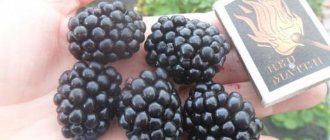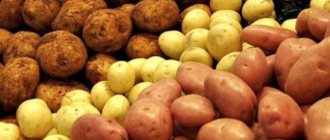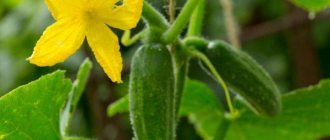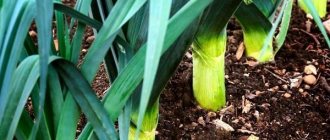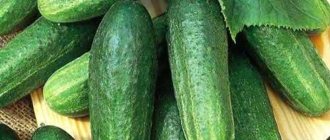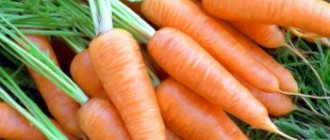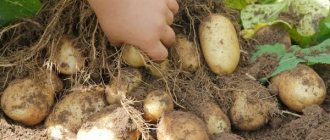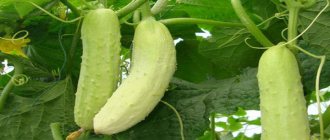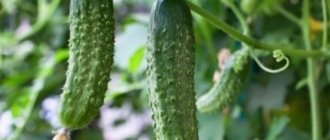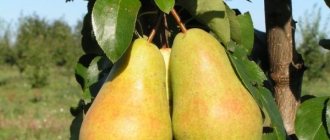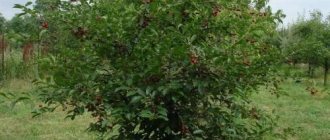The most productive cucumber varieties for 2021 can be divided both by ripening time and by growing conditions. The choice of a specific representative of a vegetable crop is also influenced by the agroclimatic features of the cultivation region. It is worth getting acquainted with the best varieties, their names, descriptions, and photos of fruits long before the start of spring field work. And the advice and recommendations of experienced vegetable growers will help you not to make a mistake in your choice.
Early (precocious)
Masha
This is a universal hybrid that is resistant to dangerous diseases, including powdery mildew, viral mosaic and cladosporiosis. It is a self-pollinating variety and therefore does not depend on insects. 6-7 ovaries are formed in the nodes, and the size of one greenery is about 80-110 mm. The harvest can be harvested on the 36th day after planting. Cucumbers have a cylindrical shape with a medium-thick skin, which is covered with large tubercles with small spines. The pulp is devoid of bitterness.
Hermann
The growing season of this variety is 35-40 days. Bears short, lumpy fruits without bitterness. They can be eaten fresh or used for preservation. It is worth considering that the plant does not develop at temperatures below 8 degrees.
Baby
Bears fruit 30-40 days after germination. They can be eaten fresh or used for storing for the winter. These cucumbers are bee-pollinated, so they grow only in open ground. They must be consumed within 10 days after harvesting, since then they lose their taste.
Madam
It bears fruit on the 48th day after planting, weighing up to 85 g. It grows in bunches, each of which has up to 7 cucumbers, which have a thin skin with small tubercles. Great for pickling and making salads.
Delicious
This is a vigorous bush that produces small greens weighing up to 140 g and up to 13 cm long. Cucumbers have loose skin and sweet, crunchy flesh. They are great for pickling. This variety is resistant to diseases and tolerates short-term drops in temperature.
Bunch varieties
Unlike other varieties, in bunched plants several ovaries are formed at once in one node, the exact number of which depends on the growing conditions. On average, hybrids can form from 3 to 9 ovaries on each node, which increases the yield several times. They are planted mainly on small plots of land because they take up minimal space.
The most productive varieties among them are:
- Prestige . This is a domestic selection variety that bears fruit 43-45 days after germination. Often lands in central Russia. At each knot, 3-4 ties are formed, and from 1 square. m you can harvest up to 25 kg of crop. Cucumbers have large tubercles and spines, and the flesh is not bitter and juicy.
- Beam splendor . From 3 to 7 ovaries are formed on one set, which ensures high productivity - up to 400 g of cucumbers can be harvested from one bush. The variety is planted in the north of Russia because it can withstand temperature changes.
- Snowstorm . This is a hybrid of the female flowering type. On one string, 5-6 greens with yellowish stripes appear, 8 cm long and weighing up to 60-70 cm.
- Detinets . The hybrid has a predominantly female type of flowering. At almost all flowering nodes up to 5 ovaries are formed. Cucumbers are up to 12 cm long and weigh about 100-120 g. The skin has small tubercles and light brown spines.
- Thumb Boy . The plant is resistant to many diseases, including powdery mildew, olive spot, and downy mildew. From 3 to 6 ovaries are formed in each sinus. The fruits are distinguished by their bright green color, large tubercles and white spines. On average, their length is 8-10 cm.
Cucumber variety "Prestige"
Cucumbers “Beam Splendor”
Variety "Blizzard"
Cucumber variety "Boy Thumb"
Medium ripening
These varieties ripen in mid-summer, have the most pleasant taste, many types are well transported and stored for a long time without losing their properties. Zelentsy ripen abundantly after 45-55 days from germination. Let's highlight the most popular:
- Libella F1;
- Picas F1;
- Steppe;
- Topolek F1;
- Claudia F1;
- Stork;
- Lilliputian F1;
- Farmer F1;
- Mother-in-law F1;
- Solar;
- Table.
If summer is usually slow to arrive in a region, it is better to choose only these varieties, dispensing with the early ones.
Cold-resistant varieties
Another important characteristic of a crop for planting in open-air beds is resistance to low temperatures. Breeders have developed many cold-resistant hybrids that do not reduce yields even in unfavorable conditions. Among them:
- “ Metelitsa ” is cold-, heat-resistant and productive. A parthenocarpic hybrid with bunched ovaries, up to 11-13 gherkins can ripen on a bush at the same time. Grown for pickling and marinades;
- “ Siberian bouquet F1 ” - is distinguished by easy care and high yield of greens. Ripens together, the fruits are thin, 7-10 cm long, gherkin-type. The pulp is juicy, without voids, there are no seeds. The skin is dark green, the tubercles are frequent and small;
- “ Chinese cold-resistant ” is a unique frost-resistant cucumber with long fruits. Popular among summer residents of the Far East, Siberia and the Urals, and the North-West. It bears fruit until autumn, delighting with greenery up to half a meter long. Cucumbers with glossy, lumpy skin and sweet and tender flesh. The taste is pleasant, there is a cucumber aroma. Used for slicing, vitamin salads, fresh juices. It is also suitable for preparations, but only when marinating and salting in slices;
- " Eskimo " is a cucumber for cold regions. Productive, but requires pollination by insects. At the peak of fruiting, greens ripen in clusters, 3-5 pieces in the axils. Gherkins are 7-10 cm long, dense, with thin skin, dark green in color. The pulp is juicy, with a crunch, while the characteristics are fully preserved in the preparations;
- “ tundra ” is a productive parthenocarpic for the northern regions (Karelia, Arkhangelsk, Vologda, Leningrad regions, Komi). Shade-tolerant, with vigorous side shoots and a powerful central stem. The greens come in bunches, 3-4 pieces each. Suitable for pickling and pickling;
- “ Zabiyaka ” is the best cucumber from a line of shade-tolerant and cold-resistant hybrids. Created in, intended for the northern regions. Produces a stable harvest even in unfavorable weather conditions. The fruits are tiny, 6-7 cm long, good taste, pulp without bitterness.
Planting cucumbers in the garden is a common thing for gardeners in the south. But in other regions of Russia, summer residents sow crops in the open air. By choosing the right varieties, you can even get an excellent harvest of juicy, crispy cucumbers in the garden beds.
Late
These are crops that ripen in 50-70 days. Among late-ripening varieties, the best harvest will be brought by:
Chinese miracle
It is a universal crop that produces cylindrical greens with thin skin, 55 cm long and an average weight of 500 g. About 30 kg of harvest can be harvested from one bush.
Chinese climbing
It has a mixed type of flowering, produces cucumbers measuring 100-120 mm and weighing 100-130 g. It is characterized by stable yield, high pickling quality, resistance to frost and disease.
Phoenix
It also bears fairly large fruits - up to 220 g. The pulp is sweet and crispy.
Crunch
A universal hybrid that is highly resistant to diseases. Pollinated by bees, produces tuberous cucumbers measuring 80-100 mm and weighing up to 80 g.
Winner
It bears fruit in long cucumbers that have large tubercles and grow until frost. Practically not affected by diseases.
Ultra early cucumbers
Most summer residents prefer to plant early ripening varieties and hybrids in open ground. This is especially important for temperate regions, where there is a high risk that cucumbers will be exposed to the August night cold.
Cucumbers received positive reviews:
- " Anzor " is an ultra-early cucumber from Dutch breeders. It ripens already at 34-36 days and produces gherkins of good taste. Advantages in high productivity, stress resistance, stability of fruiting. The ovaries are arranged in bunches, the gherkins are small, up to 7-9 cm, with aromatic pulp;
- “ Siberian courtyard ” - very early, productive. The gherkins are emerald in color, with large tubercles, no more than 9 cm in length. The hybrid form is resistant to infections and bears fruit even in bad weather conditions;
- “ Vyatich ” is an ultra-fast ripening plant from Turkish breeders. Highly appreciated by farmers and ordinary gardeners for the attractiveness and excellent taste of the fruits and unpretentiousness. Zelentsy are slightly elongated, up to 14 cm, with juicy pulp. There are no empty spaces inside, there is an aroma. Resistant to peronosporosis;
- " Bidretta " is a very early hybrid of domestic selection. The first cucumbers are picked already on the 30-35th day. Ovaries in bunches, 3-5 pieces. Zelentsy are dark in color, weighing 100-110 g, with frequent tubercles. There is no pubescence, the flesh is without bitterness, pleasant taste;
- “ Apogee ” is a bee-pollinated cucumber. Brought out by domestic breeders, fruiting occurs in 35-37 days. The pulp of greens is tender, sweetish, without bitterness. The hybrid is resistant to major crop infections and is easy to care for;
- " Amur " - early, with moderate branching. Zelentsy ripen quickly; within 32-35 days after emergence, the harvest can be harvested. Used in salads and for preparations;
- “ Serpentine ” is a variety from the group of bee-pollinated species, early, productive. Bred by breeders of Western Siberia, adapted to the conditions of temperate climate zones. Bushes on ridges grow up to 1-1.2 m, the ovaries are formed in bouquets. The first greens are ready for harvesting in 32-35 days. The fruits are light green with blurry white stripes and black spikes on the skin. The pulp is not bitter, it is juicy and dense. The “serpentine” has prickly thorns. Therefore, before processing or slicing into salads, cucumbers are carefully “polished” with a brush;
- “ Miranda F1 ” is a white-thorned early cucumber of the parthenocarpic type. Ripens in 32-35 days and is characterized by increased cold resistance. It is cultivated on ridges in different regions of the country (Caucasus, middle zone, North-West, Urals, Siberia). Zelentsy are up to 12 cm in length, with thick tuberous skin. Use - salads, canning, pickling;
- “ flagship ” is a plant with highly marketable greens. The female type of flowering predominates; cucumbers are ready for harvest after 34-35 days. The fruits are elongated, up to 18 cm, with large sparse tubercles, classic taste;
- " ABC " - early ripening of bunch gherkin type from. Ripens on 35-37 days, in the axils there are from 4 to 6 ovaries. The cucumbers are black-thorned, oval, great for pickles and pickling. To obtain high yields, pollination by bees is required. Replanting pollinating varieties gives good results.
The highest yielding crops
You can get a big harvest only with good care, but there are hybrids that are real record holders for fertility.
Sparta F1
A wonderful variety for those who want to pick cucumbers all summer. The harvest reaches 11.5 kilograms per square meter; it is harvested from July to October.
Sparta produces fruits 6-12 centimeters in length. Cucumbers are covered with white fluff, light green in color. They grow only in open ground. They do not succumb to diseases. Not intended for blanks.
Pickle F1
The fruits grow up to 90-100 grams - dense and not long. They are dark green in color with small tubercles and white edges. Village pickle under cover produces up to 14.5 kilograms of greens per square meter.
When pickled and preserved, it crunches like fresh and has a pleasant taste in salads.
Zozulya F1
It grows well in vegetable gardens and greenhouses, as it tolerates excess and lack of moisture well. Cucumbers are long (15-25 centimeters), weight reaches 160-200 grams.
The harvest reaches record values - up to 16 kilograms per square meter. This amount of greens will not go to waste - cucumbers are tasty and suitable for salads, they also retain their density and crunch in any preparation. Zozulya is a true all-rounder.
Which hybrids and varieties of cucumbers are best suited for growing in open ground?
For obvious reasons, it is believed that bee-pollinated hybrids and varieties , and parthenocarpic hybrids (not requiring pollination) in a greenhouse.
Interesting! On the packages of some parthenocarpic cucumbers it is written that the hybrid is intended for closed ground (greenhouses). But this does not mean that you cannot plant it in open ground, because among the main advantages of growing parthenocarpic cucumbers in open ground are the following: they tolerate temperature changes better (for example, if you have an unstable climate), get sick less, and are stored well , do not turn yellow and do not lose their presentation for a long time.
In addition, for pollination you do not need bees (bumblebees) , which you may not have in sufficient quantities at all (although you don’t need a lot of them).
Before buying cucumber seeds, namely choosing a specific hybrid or variety, you should ask yourself a few questions:
- In what place will your cucumber bed - in the sun or in partial shade?
By the way! It is believed that only some self-pollinating cucumber hybrids can bear fruit normally in low light conditions, but almost all are bee-pollinated. However, a sufficient number of shade-tolerant, both parthenocarpic and bee-pollinated cucumbers have now been bred.
- Are you planning to collect cucumber seeds , that is, do you need varietal seeds (yes) or hybrid seeds (no, because the seeds of F1 hybrids do not retain their maternal properties, there is no point in collecting them)?
By the way! How to properly collect and prepare cucumber seeds is described in detail in this article .
- How much harvest do you want to get (yield characteristics)?
- How resistant is the variety to diseases , and how often will it be necessary to treat diseases?
- What do you want to do with the harvest, how to use it (type or purpose): eat it directly ( for salad ) or process it ( pickling, pickling, canning )? However, many hybrids and varieties are of universal use . But as a rule, long cucumbers are used in salads, and short ones (gherkins and especially pickles) are used for pickling and canning.
Also, depending on the ripening period, cucumbers are divided into early (early ripening), medium or late ripening. But all popular varieties , as a rule, are early or early ripening.
Next, a brief overview and description of the most popular hybrids and varieties of cucumbers for open ground will be presented, depending on the type of pollination: self-pollinating (or more correctly, “ parthenocarpic ” or “not requiring pollination”) and bee-pollinated .
Interesting! How to easily distinguish a hybrid from a variety:
- The hybrid first develops a small cucumber, and then a flower opens on it .
- At first, the variety simply has a yellow flower , which is not guaranteed to become a cucumber (perhaps it is a male flower).
Varieties for the greenhouse
Greenhouse varieties are in demand in many regions of Russia. In cold summers, this is the only opportunity to get homemade cucumbers. But even in warm areas, growing in a greenhouse helps extend the fruiting time.
Alekseich F1
Cucumbers grow quickly in greenhouses, even without heating, if the soil temperature has reached 15 °. The soil required is light, with full aeration. The node contains 2-3 fruits. The cucumbers ripen at the same time, and 13-14 kilograms are removed from the bush per season.
Table of zoned varieties and hybrids
Let's consider which varieties and hybrids are best grown by region.
| Region | Variety |
| Central and Central Black Earth | Noble Master Twixie Brunette Vulcan Kristina Business Yamal Katyusha Cornet Throne Chernomor Debut Chizhik Cook Pasmonte Nightingale Krepysh Svyatoslav Spasan Finger Style Prestige Brother Ivanushka Groom Wagner Staff Diana |
| Northwestern | Pharaoh Baron Tycoon Trilogy Royal Tycoon |
| Middle Volga and Lower Volga | Siskin Vertina Nightingale Desdemona Neylina Rezastr Semcross Octopus Puccini |
| Eastern and Western Siberia | Augustine Tanik Brigantine Sashenka Vector Diva Vitan Prestige Granddaughter Hedgehog Dimka Groom Bride Newcomer Altai Octopus |
| North Caucasian | Chizhik Nightingale Cruise Rezastr Sokol Lastoka Bride Wagner Karaoke Vertina Zircon Asterix Alekseich Capra |
Cucumbers for open ground
When growing by open method, it is necessary to especially carefully consider the varietal division by region. Zoning is an important element in selection; hybrids are created taking into account the most important characteristics of the area.
Self-pollinating or parthenocarpic varieties
Most plants require pollination to form fruit. Eliminating dependence on insects is one of the tasks of breeders. New varieties are coming to the aid of gardeners:
- Self-pollinating - pollination occurs on one plant (there are pistils and stamens). When the seeds ripen, the fruit turns yellow and dries out.
- Parthenocarpic plants produce only female flowers. The fruits do not turn yellow, there are no seeds or they are in rudimentary form, they are stored well, and produce a long and abundant harvest.
Among the disadvantages, we note the highest cost of seeds for hybrids of this species.
Prestige F1
This variety has a lot of undoubted advantages:
- long fruiting;
- sweet, without bitterness, greens;
- ripening in 42-45 days;
- beautiful shape: length – 10-12 centimeters, weight – 70-95 grams;
- thin skin, crispy flesh;
- tolerate transportation well.
Prestige is used fresh and for a variety of preparations.
Son-in-law F1
A good variety for the garden and greenhouse. Zelentsy have a diameter of 3.5 centimeters and a length of about 10-12. The ovary is grouped in bunches of up to 8 pieces. The variety is productive - up to 50 bunches on a bush; up to 7 kilograms of fruits are collected from a bush over the summer.
Zyatek has good taste characteristics; it is better to pick it in the form of gherkins. It practically does not get sick; gardeners appreciate this variety for its unpretentiousness and ease of cultivation.
Claudine F1
Harvesting Claudine facilitates the open appearance of the bush. The greenery is 8-10 centimeters in size and weighs 80-90 grams. There are light stripes along the dark green skin, the bumps are small, but the cucumbers prick your hands very much. It is better to assemble with gloves. Up to 7 kilograms of excellent quality fruits are harvested per square meter.
Claudine is considered a salad variety, has a pleasant taste, but becomes softer in any type of preparation. The bushes tolerate heat well. From germination to harvesting – 38-40 days.
Metelitsa F1
The fruits are ready 37 days after emergence. The ovary is grouped into 4 pieces in a bunch. The cucumbers are small (7-8 centimeters, up to 70 grams) and have a regular cylindrical shape. The color of the greens is bright green, white stripes cover the cucumber up to the middle.
Planting - seeds in the ground and seedlings. Metelitsa is well suited for any method of use - fresh and for preparations.
Bogatyr strength F1
Cucumbers produce a large harvest - up to 20 kilograms per bush. If you collect greens in time, the plant bears fruit until September. The bush grows weakly, without taking away strength during the formation of the ovary and the growth of fruits.
The skin of the fruit is dense, the core is filled with pulp, and there are few seeds. Size – 8-14 centimeters, thickness – 3 centimeters. They are well stored (14 days without loss of quality) and transported. Good fresh and canned.
Basic principles of variety classification
When choosing a crop variety, you need to focus on what the gardener expects from the harvest. The classification is based on several characteristics. For example, if we talk about pollination ability, there are:
- Parthenocarpic - a class that contains cucumbers without pollination. There are simply no seeds inside cucumbers.
- Self-pollinating crops contain seeds in their fruits. Inflorescences have a pistil and a stamen.
- Plant species that are pollinated are not able to bear fruit if there are no insects.
In the classification of cucumbers there are hybrids that can be recognized by the designation F-1. Systematization in this case occurs on the basis of frost resistance.
Expert opinion
Stanislav Pavlovich
Gardener with 17 years of experience and our expert
Ask a Question
There are varieties designed to produce gherkins - small fruits. Pickles are very small cucumbers obtained by stopping the development of the crop.
There are varieties suitable for pickling or salads. Salad cucumbers are distinguished by their oblong, long appearance and smooth skin. They can be stored for a long time, but are absolutely not designed for pickling. Pickled fruits are of a size that allows them to be placed in containers for preservation. The skin of such varieties of crops perfectly absorbs marinade or brine. Without seaming, pickling varieties are not stored for a long time, they dry out and die.
Classification by shape and size: bush plants with a small stem (up to 0.5 m). As a rule, such a crop looks like a bush and quickly produces a harvest.
There are species with bunched ovaries, when up to 10 fruits are observed in a bunch. Most cucumbers ripen early.
Influence of region on variety choice
To obtain a rich harvest of high-quality fruits, the regionalization of representatives of the vegetable crop is taken into account. For areas with harsh weather conditions, breeders have developed cold-resistant varieties, while for hot ones - drought-resistant varieties. Thanks to constant work at experimental stations, hybrids have been obtained in which, at the genetic level, the bitterness in taste that appears during moisture deficiency has been removed.
In most regions, due to the unfavorable climate, cucumbers demonstrate yields in open ground that are several times lower than when grown in a greenhouse.
In warm areas
Crimea, Krasnodar Territory, the Caucasus are zones where a vegetable crop is able to realize the potential declared by the originator without any shelter. Popular representatives:
- “Droplet” is an early-ripening, universal form. The bush is medium-sized, mainly female inflorescences are formed. Zelentsy have an oval, slightly elongated shape. They are strewn with large pimples and black spines. Weight – 60-75 g.
- “Crane F1” - specially obtained for open ground in the southern regions on experimental fields in Crimea. It has very high productivity due to the formation of 4-5 cucumbers in each internode. We pollinate bees.
- "Adam F1" is a German hybrid of the gherkin type. The maximum weight of leveled fruits of dark green color is 70 g. The tuberosity is pronounced.
For the middle zone and Moscow region
For this zone, the choice of suitable vegetable representatives is the widest. Best cucumbers:
What seeds should I use for the garden?
Protected soil and a favorable greenhouse microclimate are no substitute for fresh air, nutritious rain, and the rays of the spring sun for plants. Moreover, from a large plot of land you can get an unlimited amount of appetizing product. Understanding this, you should know which varieties of cucumbers are the best for open ground. These are the seeds you need to take with you when you go out to your garden in the spring.
“April F1” – early bird of spring
This hybrid is not afraid of cold weather. The appearance of the harvest can be observed on the 45th or 55th day after germination of the first shoots. Some gardeners start planting seeds very early. In such cases, it is necessary to use a film to create a greenhouse effect.
Over the next 30 days, the ovaries form together. However, the best results were recorded due to two factors: early planting and pollinating insects. Thanks to this, a farmer will collect from 7 to 13 kg (per 1 sq. m) of harvest from his small plantation. These cucumbers are characterized by the following characteristics:
- large size: 20-25 cm;
- optimal weight – from 200 to 250 g;
- tubercles are small and sparsely located;
- white spines;
- the greenery does not turn yellow and does not overgrow.
Many people like to grow this crop because it does not require much care. The bush has a compact shape, since the branches themselves control the degree of their growth.
It is recommended to plant seedlings in open ground 15-20 days after sowing. The seeds are deepened only 0.5 or 1 cm into the soil. You can make 2 parallel beds, between which there should be at least half a meter of width.
"Masha F1", but without the bear
Among the 15 best varieties of cucumbers for growing in the middle zone, this one is considered the leader in terms of ripening speed. Only 35 days and a salad of aromatic gherkins will become an original addition to the holiday table. The harvest is massively harvested already on the 40th day, which allows them to be preserved. As a result, they turn out crispy and juicy. The distinctive features of the Masha F1 variety are:
- correct, almost even shape of the fruit (up to 10 cm);
- pimply surface with large tubercles;
- sweet taste, without the slightest bitterness;
- high yield over a long period;
- tolerance to unfavorable conditions.
The mosaic virus, as well as powdery mildew, bypass the crop. However, over time, white rot or anthracnose may appear on the leaves and stems.
To avoid the bush being affected by diseases, you need to fertilize the soil with mullein or humus, and also disinfect the seeds before planting.
"Competitor" to everyone else
The branches of this hybrid develop so strongly that they can reach 2 meters in length. With the help of graceful tendrils, the plant clings to fences or other structures. Yellow flowers form on the stems and release pollen. It is viable for just a few hours, so it is advisable to plant the crop near an apiary. As a result, after 1.5 months you can go out to the garden with baskets to collect the harvest, and so on for the next 3 months. These greens have:
- oblong shape;
- 12 centimeter fruit;
- weight about 120 g;
- large pimples;
- long stalk (this is a bonus for assembly);
- ribbed surface painted with white stripes.
Sudden temperature changes negatively affect fruiting. In this regard, the site must be protected from such anomalies using various devices.
“Springhead F1” – a source of refreshment
It belongs to the category of mid-season varieties, since the first fruits on the stem can be picked 55 days after the seeds germinate. The inflorescences of the plant are pollinated thanks to the active work of bees. Up to three knots are tied in one bunch, and the stem itself can sprout up to 5 shoots. Zelentsy reach 12 cm, gaining weight up to 100 g. Outwardly, they look like light green barrels with small pimples. Since the black thorns are not very dense, picking the fruits is much more convenient. These cucumbers retain their taste even when pickled or canned.
To get about 25 kg of greens, you need to grow the variety using a trellis method. Otherwise, this figure drops to 5-7 kg.
"Ant F1" is not an order of Hymenoptera
What you need to know about this hybrid variety of cucumbers is that the stem does not produce long side shoots, so the bush is compact. Flowers are pollinated without the intervention of bees. The fruiting period begins after 35 or more days. This is much earlier than with other early ripening plants. Despite this, they bear fruit for a relatively short time. Externally, greenies resemble real ants, only under a magnifying glass:
- rare black spikes;
- smooth gradation of color from pale to marsh with pronounced white stripes near the nose;
- oval-cylindrical outline of the fruit;
- in section it can be up to 4 cm;
- The pulp density is average.
Of course, they are several times longer than insects - almost 11 cm. Up to 3-7 cucumbers are tied in one bunch at once. Therefore, from a small plot, a summer resident can expect up to 12 kg of a bountiful harvest.
When growing them in a container, the seedlings should be watered, maintaining the temperature in the room at least 12 degrees. It is advisable to transfer it to the ground when the seedlings have 3 to 5 leaves.
"Erofey" from the Russian hinterland
This true all-rounder is suitable for any culinary experiments. The variety amazes everyone with its paradoxical nature. On a thick, lushly growing bush, miniature greens (only 6-7 cm) “show off”. These oblong fruits are somewhat reminiscent of chicken eggs, but with some differences. The peel has small tubercles and is decorated with symmetrical light green stripes. The type of flowering in the Erofei variety is mixed.
Seedlings are transferred to open ground at a temperature of +15°C. In this case, the beds need to be weeded, removing weeds and loosening the soil. During the growing season, you should not neglect fertilizing. It is worth watering the crop in the evening hours.
In addition to the varieties mentioned above, many farmers successfully “collaborate” with other hybrid varieties. Among them, “Phoenix” is popular, for which it is necessary to build a temporary shelter from film in the garden bed. But this is only at first. While “Far Eastern” withstands almost all the vagaries of nature.
Review of the best popular varieties for 2021
We offer a list of varieties with the best characteristics for growing in open ground.
Delicious
This early-ripening species is suitable for growing in open soil. The plant grows powerful, its distinctive feature is long lashes.
The fruits are characterized by a cylindrical shape, finely tuberculate, smooth. They stretch up to 12 cm in length. The skin is not rough, rich green in color. The pulp contains a high percentage of sugar and is dense. The seed chamber is small in size. The variety is suitable for conservation.
The productivity is high, approximately 7 kg of fruits are harvested from 1 m2. The delicacy variety tolerates short-term cold snaps. The fruiting period is long.
Seeds or seedlings are placed in the soil in late May.
Son of the regiment
The plant, called “Son of the Regiment,” is characterized by medium size. The variety is bee pollinated. The fruit has an oval shape, small tubercles. The length of greens is 9 cm. The taste is high. The son of the regiment is resistant to scab. Vegetables are harvested 45 days after planting. Productivity is good. Used for pickling and seaming.
Madam
These hybrid gherkins are characterized by high yield. The variety requires pollination. The crop is grown in greenhouse conditions or open soil. Cucumbers ripen 40 days after planting.
The fruits are smooth and small in size. The skin is thin. The view can be reserved for the winter. The plant is characterized by a bunched arrangement of ovaries. There is no bitterness. The variety is resistant to diseases.
Alligator
The variety is eaten fresh. The plant has a female type of flowering. Branching is small. The alligator is immune to diseases. The cucumber is long in shape, rich green in color, small tubercles, with a white edge. The pulp is juicy, without bitterness, with a sweet aftertaste.
The alligator adapts to different climatic conditions and provides high yields.
The variety is considered heat-loving; it is provided with large amounts of ultraviolet radiation. It is worth planting in warm soil.
Chinese disease resistant
The variety resists diseases to which cucumber crops are susceptible. The plant is not afraid of: downy mildew, fusarium, powdery mildew. By the way, the plant has nothing to do with China. Bred by breeders from the Moscow region.
The plant has powerful vines that grow all the time, so you can’t do without a trellis. The fruits look like parts of a cut polyethylene pipe and have pimples. It is characterized by a pleasant taste, highly productive and resistant to cold. Breeders have made every effort to ensure that this variety does not have bitterness at the genetic level.
The variety is grown in open soil in the south. In the central regions, the crop is also sown, but in greenhouses.
April
Belongs to the parthenocarpic type. But if an insect lands on the crop for pollination, this will increase the yield of the variety. Cucumbers are ribbed and cylindrical in shape. There are small bumps. The skin is bright green in color. The liana weaves medium. April is considered a high-yielding variety. Cucumbers are up to 25 cm long, weighing up to 300 g. The species is characterized by average resistance to diseases, the weak side is white rot.
Erofey
Erofei belongs to the group of mid-season cucumber varieties. This variety is bee pollinated. The culture is growing rapidly. The bush itself stretches high. Cucumbers are small in size, about 7 cm long. In appearance, the vegetables look like an oblong egg. Surface with bumps. Successfully resists downy mildew.
Corinna
The variety is considered early ripening. Corinna is in the group of the most productive species. Can be placed in open ground. Cucumbers are characterized by their small size, with a length of 11 cm. Cucumbers have a rich color, the surface is slightly bumpy, with white spines. Cucumbers do not have a bitter taste.
The variety is adapted to diseases. Suitable for seaming.
Maintenance is simple: constantly moisten the soil and apply fertilizers on a schedule.
Connie
High-yielding cucumbers. The culture easily adapts to unfavorable weather conditions and resists diseases. The fruits of the species are distinguished by their cylindrical shape, pleasant aroma, and lack bitterness. Cucumbers stretch up to 10 cm in length and weigh 80 g.
Planting material is sown in loose soil, the temperature of which should not be lower than 14°C. The first cucumbers can be harvested two months after planting.
Nezhinsky
The variety was bred by specialists in the field of breeding a long time ago, but its popularity does not fall over time. The species is bee pollinated. The first fruits can be seen after 2 months. The vegetable can be consumed fresh, rolled or salted. The species is characterized by excellent quality.
The pulp is juicy, the cucumber itself is crunchy, there is a little sweetness. The skin is not thick, not smooth, with small black spines. The plant is considered resistant to diseases, so it is often chosen by experienced gardeners.
The variety is recommended to be grown in open soil, but at first the crop should be covered with film. The species does not develop very well in a greenhouse, since Nezhinsky requires natural pollination. In addition, cucumbers are characterized by long vines that need space to live freely.
Top 5 for greenhouses
Most people do not want to deprive themselves of the pleasure of eating greens, which is why they choose this method of growing them. The coolness outside is not a reason to rest on your laurels, because there is a lot to do in a greenhouse/greenhouse. They are in a hurry to choose the best varieties of cucumbers for their greenhouse. The main features of such growth “sprinters” are that the side shoots of the plant do not need to be pinched. Shortened weaves form a compact bush. It is not very lush, so moisture does not collect in its foliage. After all, because of it, the stem can begin to rot, and the greens can become covered with powdery mildew. Among the many hybrids bred, it is worth highlighting 5 that are well suited for the Greenhouse mission.
“Murashka F1” is a favorite of many
This variety is a generalist in the truest sense of the word. It bears fruit well in any conditions: greenhouse, vegetable garden or balcony. In addition, it is not afraid of bad weather conditions. The fruits set even on cool days. Since greens have an excellent taste, they can be used for various preparations. Culture is also valued for:
- early maturity (maximum 45 days);
- high productivity, because more than 3 ovaries are formed near the leaves;
- visual attractiveness (the dense bush grows to medium size without sending out many long shoots);
- original taste qualities: unsurpassed aroma, crispy flesh and lack of bitterness;
- the dark green fruit (12 cm) is covered with black spines, which are planted on large tubercles.
This characteristic makes this hybrid the first in the top five best varieties of cucumbers for the greenhouse. The age of seeds for sowing must be 3 years or more. Before planting, it is important to disinfect them with a solution of potassium permanganate.
The germination rate of the Murashka F1 variety is very high, so the beds need to be thinned out. Otherwise, the plant will grow slowly. Moreover, the recess in the groove is made up to 5 cm.
“Emelya F1” – from peasant to prince
Initially, breeders developed it as a salad sub-variety, but later many housewives began to use the fruits for canning/pickling. The Emelya F1 hybrid tolerates cool cyclones without problems, while giving excellent yields in bad weather conditions. However, ovaries, as well as fruits, develop more actively in rooms with heating systems. The characteristic features of this culture are:
- self-pollination;
- flowering - female;
- establishment of bunch-type ovaries;
- 40-45 days of the growing season;
- moderate branching;
- the fruit is spindle-shaped, 15 cm in length and weighing 120-150 g (diameter up to 4 cm);
- the skin is thin and without a bitter taste;
- the coarsely tuberous surface is covered with white spines;
- shade – rich green;
- leaves are slightly wavy with a smooth edge.
From one square meter, a farmer can harvest from 12 to 16 kg of crop. However, it is important to ensure that the leaves are not affected by downy mildew or cucumber mosaic virus. This often happens with hermaphroditic fetuses.
Specimens need to be planted at a distance of 50-75 cm. Then the plant can successfully develop in a greenhouse.
“Benefit performance F1” – the performance is not over
It can take either 40 or 50 days from sowing to the appearance of full-fledged fruits. At the same time, the flowering (mostly female) pollinates independently, without the intervention of insects. Each leaf axil has one pair (2 pieces) or a whole “quartet” (4 pieces) of ovaries, 8 mm long. From them grow sophisticated 10-centimeter oval-shaped greens.
From a small piece of land (1 m²), a farmer can get up to 6-8 kg of elegant gherkins. Behind the elastic fruits lies a delicate and sweet taste. Zelentsy "Benefit F1" tolerates transportation well and retains its properties during long-term storage. Many people grow cucumbers for sale. The culture grows well in moist soils, which makes it resistant to merciless powdery mildew and root rot.
For seedlings, their seeds are sown in late April. Experts recommend transferring young seedlings to land only after a month.
They call him “Alekseevich F1”
Despite such a high-profile title, these gherkins grow up to 8 cm in length. The girth of a miniature fruit in the form of a cylinder is no more than 4-5 cm. Still, many prefer the Alekseevich cucumber variety, because its yield is 14 kg/m². These greens are suitable for pickling and salting. But for such purposes, they need to be collected in time, when they are no larger in size than pickles or gherkins. Millions love them for their unique features, namely:
- crust without tubercles and sharp spines;
- do not taste bitter;
- greens ripen almost simultaneously;
- germination is observed earlier than all other varieties;
- fruits can be harvested 38-43 days after germination;
- growth and branching are average.
This crop bears fruit from May until almost October. The inflorescences do not fall off and are rarely empty. The fruits grow evenly, without curling.
For successful fruiting of the variety, you need to maintain the room temperature at least 12-15°C.
"Boy Thumb" comes from a fairy tale
The first fruits appear 40-45 days after sowing the seeds. Oval-shaped dark green cylinders covered with small spines. The tubercles are not very clearly expressed. The peculiarity of this hybrid is that all cucumbers are the same size. The bush is so thickly covered with them that a square. meter you can collect up to 14 kg of such wealth. In this case, each individual instance will:
- weighing 50-60 g (maintaining all its juiciness);
- up to 10 cm long;
- 3-4 cm in diameter (without thick skin).
In just one bunch the housewife will find up to 6 ovaries. It is noteworthy that barren flowers are very rare. The bush has an impressive appearance, but the shoots weave weakly and do not grow much.
Since the fruits outgrow, they need to be collected on time, that is, every 2 days or even more often. As soon as they grow to 6-8 cm in length, it is recommended to pick them.
The best varieties of cucumbers for canning
Here, thin skin, dense pulp and, of course, the small size of the fruit are the main components. It is important here that cucumbers do not lose their properties after heat treatment. Gherkins will be good for this purpose. Which are only 5 - 8 centimeters in size.
| Hermann | Early 38 - 41 days, Determinate, medium tuberculate with light spines, Parthenocarpic bunched 4 - 6 flowers, fruit length 10 cm, weight up to 100 g. |
| Hector F1 | Super early 35 - 40 days, Determinate up to 0.8 m, large tuberculate with light spines, Bee pollinated with a predominance of female flowers, fruit length 10 cm - 12 cm, weight up to 100 g. |
| Courage F1 | Ultra-early 35 - 40 days, Medium-sized, medium-tubercular with white spines, Parthenocarpic, bunched from 2 to 10 ovaries, fruit length 13 cm - 14 cm, weight up to 130 g. |
| Phoenix | Late 50 - 60 days, Indeterminate, vigorous, white spines, medium tubercles, Bee pollinated, fruit length up to 14 cm, weight up to 150 g. |
| Aquarius | Mid-early 45 - 50 days, Determinate up to 1 m, large-tubercular with light spines, Bee-pollinated, fruit up to 14 cm, weight up to 110 g. |
| Moscow Nights | Mid-early 40 - 45 days, Vigorous, sparse large tubercles with white spines, Parthenocarpic bunched 1 - 3 flowers per node, fruits 12 cm - 14 cm, weighing 90 g - 100 g. |
| Marinda F1 | Mid-early 40 - 45 days, medium-sized, with sparse large tubercles and white spines, Parthenocarpic bunched 5 - 7 flowers per node, fruit length 8 cm - 10 cm, weight 60 g - 70 g. |
Bush varieties
This plant is a small bush about 1.5 m high, abundantly covered with green leaves and ovaries. As a rule, such varieties are early ripening, and the most productive among them are:
- Baby . It bears fruits weighing up to 90 g, which are ovoid in shape, large tubercles and whitish pubescence. They are used for any purpose because they are universal.
- Hector . On average, it bears fruit with cucumbers up to 100 mm in size. They are distinguished by their cylindrical shape, white pubescence and large tubercles.
- Shorty . It is a universal culture. The bushes are up to 45 cm high. They grow oval or cylindrical cucumbers, light green in color and up to 90-100 mm in size. The delicate skin may have small stripes or a calico pattern.
Cucumber variety "Baby"
Cucumbers "Hector"
Variety "Shorty"
Hybrids for pickling and canning
| Lilliputian F1 | Medium late 48 - 54 days, Indeterminate up to 2 meters, large tuberculate with black spines, Bee pollinated, fruit 10 cm - 12 cm, weight 90 g - 120 g. |
| Zyatek F1 | Early 35 - 45 days, weakly climbing 1 - 1.6 m, with small tubercles, black thorns, Bee pollinated, fruits 6 cm - 8 cm, weighing 50 g - 70 g. |
| Siberian salting F1 | Medium late 43 - 53 days, Indeterminate, vigorous, large tubercles, black thorns, Bee pollinated, fruit length 10 cm - 15 cm, weight 110 g - 200 g. |
| Maryina Roshcha F1 | Medium-early 40 - 50 days, Indeterminate medium-sized, Bee-pollinated, fruit 5 cm - 8 cm, weight 70 g - 80 g, large-tubercular with black spines. |
| Hit of the F1 season | Super early 35 - 40 days, vigorous up to 2 m, fruits 9 - 13 cm, weighing 120 g - 140 g, bee pollinated, bunched, finely tuberculate, black thorn. |
| White sugar F1 | Mid-early 47 - 50 days, Indeterminate, vigorous, up to 2.3 m, large-tubercular with black spines, Bee-pollinated, fruit length 11 cm - 13 cm, weight 85 g - 95 g. |
Bee-pollinated cucumbers
A classic of the genre is cucumbers, which require pollination. Dozens of productive hybrids have been bred, and old proven varieties have not been forgotten. The only problem is that the harvest depends on the quality of pollination, since bees do not fly in inclement and cool weather. The solution is to plant several hybrids of the parthenocarpic type on the site.
Among the cucumbers that bees pollinate, there are varieties and hybrids. On seed bags, the first generation forms are marked F1.
On a note! Unlike varieties, seeds are not collected from F1 hybrids. Every year you have to buy new material.
The best hybrids:
- “ true friends ” - open ground cucumbers with bunches of ovaries up to 6-8 pieces. Originator - . Plants are powerful, indeterminate, with medium branching. The fruits are dark green, striped, with juicy pulp. The length of the greens is 10-12 cm;
- “ babies on a branch ” - at the height of fruiting, the shoots are covered with small gherkins. The hybrid with the original name is early ripening, productive (up to 12 kg/m2). To obtain high yields, regular feeding is required;
- “ Hector ” is a Dutch selection cucumber, productive and of good taste. Bushes of determinate type, weak branching. The first greens are ready for harvest in 30-32 days. The fruits are elongated, slightly ribbed, with white spines on the skin. The taste is excellent;
- " Brownie " - characterized by long-term fruiting. The greens are dense, up to 11-13 cm long, with large sparse tubercles and whitish spines. The hybrid is resistant to powdery mildew and other diseases, suitable for processing (universal), transportation and short-term storage;
- " Libelle " is an F1 hybrid from German breeders. Brought out in the late 70s, it has a classic cucumber taste and aroma. Resistant to adverse factors, productive. If watered irregularly, libelle greens may become slightly bitter;
- " Lord " is one of the best for open ground. Productive hybrid from domestic. Zelentsy reach a length of 15 cm, weigh 100-110 g. There are few tubercles on the surface. The pulp is sweetish and aromatic. From 1 sq. meters, 20-24 kg of fruits are collected;
- “ Kumanek F1 ” - according to numerous polls, it ranks among the top 10 cucumbers for open ground. Early ripening, with bunch formation. There are up to 3-5 cucumbers in nodes. Fruit length - 13-15 cm, weight - 100-110 g. Unpretentious and productive, with juicy pulp and wonderful aroma. 4-6 kg of greens are collected from the bush;
- “ Chizhik ” is a hybrid for open ground with delicate gherkins. The length of the fruit is 6-9 cm, tasty, with a crunch. The bushes are determinate, the lateral branches are shortened. Weak shoot formation simplifies the care of plantings;
- “ Walk F1 ” - with proper agricultural technology, produces up to 5-6 kg of greens per bush. Early, productive, with brown-thorned fruits 10-12 cm long;
- " Twixie " is an ultra-early F1 hybrid from. The first cucumbers are ready for harvest in 30-32 days. The plants are compact, with a small number of lateral branches. Female flowers predominate. Cucumbers are tasty, suitable for canning and marinades;
The hybrid “fontanel”, familiar to many summer residents, and the productive and aromatic “semcross” are worthy of attention.
We distinguish by type of pollination
Bee-pollinated cucumbers
. Here, I hope, everything is clear from the name alone. Here, pollination occurs by bees and bumblebees. And, this is because cucumbers are dioecious plants, where there are male and female flowers. And, to form an ovary, bees must transfer pollen from one flower to another.
The best bee-pollinated varieties and hybrids
Kumanek F1
. A bee-pollinated, mid-season hybrid with a ripening period of 45 - 48 days. The plant is medium-sized, indeterminate type. Suitable for open ground, but can also be grown in a greenhouse. It has fruits measuring 10 cm - 12 cm with large tubercles and white spines. When heat treated, it does not lose elasticity, therefore it is suitable for pickling. By the way, the plant has a good, powerful root system. And yet, it perfectly resists various diseases.
True friends F1
. Bee-pollinated hybrid with a growing season of 36 - 39 days (ultra-early). The plant is of an indeterminate type, weakly growing, but climbing. Here, there is clearly a predominance of female flowers. From 3 to 8 ovaries can be formed in one node, and this is a bunch formation. Grows in open ground and in temporary shelters. Fruits with a medium number of tubercles with black spines. Size up to 10 cm. Suitable for pickling. Resistant to cold, olive blotch and cucumber mosaic.
No hassle F1
. Hybrid, with a ripening period of 40 - 45 days. Bee pollinated. Indeterminate, medium branched. There are two female flowers in the node. Growing place: open ground and temporary film shelters. The fruit has small tubercles (there are many of them) and white spines (like pubescence). The size of greens is 8 cm - 10 cm. The taste is excellent, crispy, without bitterness. The purpose is universal. Cladosporiosis, cucumber mosaic, powdery mildew, the hybrid successfully resists all of this.
Kids on the F1 branch
. The growing season is 43 days (on average). Mid-early. Pollinated by bees. 2 - 3 ovaries are formed on one node (bunched). It is grown in open ground and under temporary film covers. The fruits are finely tuberculate with dense pubescence, which have an excellent taste and crunch on the teeth. Universal in purpose.
Brownie F1
. A mid-early hybrid that ripens within 45 - 48 days. The bush is indeterminate, medium-sized. Can be grown in open ground and under temporary shelters. The fruit is large tuberculate with white pubescence and medium-density pulp. The size is only 7 cm - 10 cm. It is universal in purpose. It resists diseases such as cladosporiosis and downy mildew well.
Libelle F1
Libelle F1
. A bee-pollinated hybrid with a growing season of 50 - 52 days. Has powerful long lashes. Grows in open ground and greenhouses. It has elongated fruits in the shape of an ellipse, 12 cm - 14 cm long. The taste and external characteristics are at the highest level. The purpose is universal. Is immune to downy mildew and olive spot.
Lord F1
. Hybrid with a ripening period of 40 - 45 days. The plant is of indeterminate type and has medium branching. One knot can tie 1 - 2 flowers. Grown in open and protected ground. Fruit with large tubercles and white spines, 10 cm - 12 cm long. Universal. Cold resistant. Resistant to diseases such as powdery mildew, olive spot, cucumber mosaic.
Elegant
. The variety is bee-pollinated, early ripening with a ripening period of 40 - 49 days. Designed for open ground. It has fruits with small tubercles and white spines 10 cm - 12 cm long. The taste is excellent. Used everywhere in cooking (universal). Relatively cold-resistant.
Chinese kite
Chinese kite
. Mid-late variety, bee-pollinated. The bush is powerful and the fruiting period is long. Designed for open ground and for growing under temporary film covers. The fruit can reach a length of 60 cm. It has sparse tubercles, a dark green color, and a serpentine appearance. The taste is excellent, the skin is thin and tender, the fruits are sweet and aromatic, the seed chambers are small, so they are best suited for fresh consumption. Loves fertile soil.
Competitor
. A variety with a ripening period of 47 - 52 days (mid-season). A powerful, highly branched plant, where the main vine reaches a length of 1.5 m - 2 m. It can be grown in open ground and under temporary shelters. The fruits here are 10 cm - 14 cm in size with large and sparse tubercles and black thorns. It is best suited for pickling and canning. Resistant to many diseases.
Baby
. An early bee-pollinated variety, with a ripening period of 40 - 43 days. A bush-type plant, where the length of the lashes is only 40 cm - 43 cm. It can form up to 6 ovaries on one node (bouquet arrangement of ovaries). It is grown in open and closed ground. Fruits with sparse tubercles and white spines, the length of which can reach 10 cm. Used for fresh consumption and for preservation.
Self-pollinating varieties and hybrids
Self-pollinating varieties and hybrids
. And again, everything should be clear to us. In this case, stamens and pistils are present in each flower. Therefore, self-pollination occurs. I would like to note that such plants are usually used for breeding purposes. And this is due to the structural features of the plant’s flowers. There are very few of them on sale.
